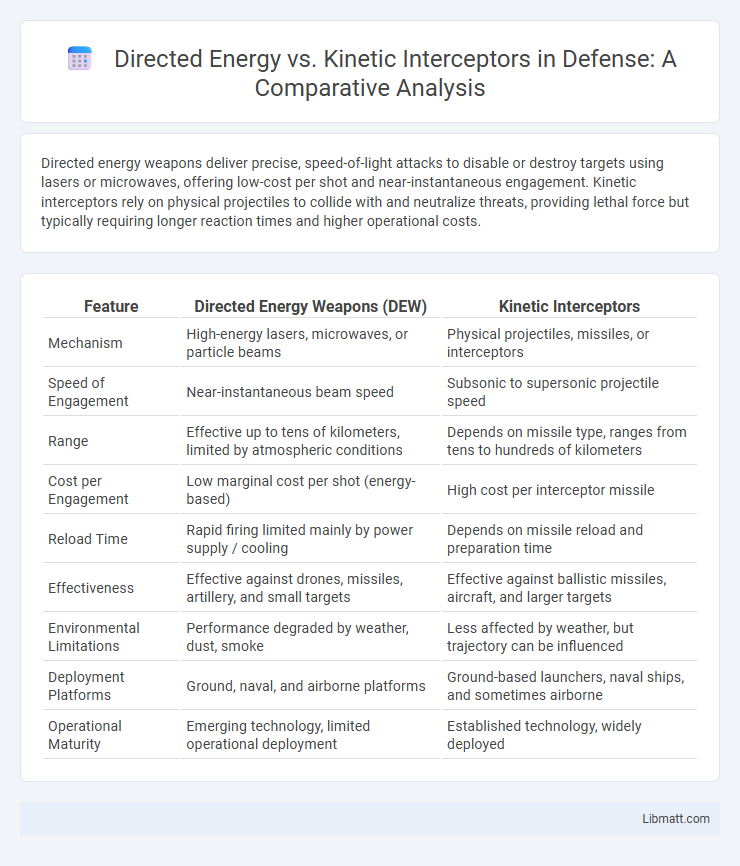Directed energy weapons deliver precise, speed-of-light attacks to disable or destroy targets using lasers or microwaves, offering low-cost per shot and near-instantaneous engagement. Kinetic interceptors rely on physical projectiles to collide with and neutralize threats, providing lethal force but typically requiring longer reaction times and higher operational costs.
Table of Comparison
| Feature | Directed Energy Weapons (DEW) | Kinetic Interceptors |
|---|---|---|
| Mechanism | High-energy lasers, microwaves, or particle beams | Physical projectiles, missiles, or interceptors |
| Speed of Engagement | Near-instantaneous beam speed | Subsonic to supersonic projectile speed |
| Range | Effective up to tens of kilometers, limited by atmospheric conditions | Depends on missile type, ranges from tens to hundreds of kilometers |
| Cost per Engagement | Low marginal cost per shot (energy-based) | High cost per interceptor missile |
| Reload Time | Rapid firing limited mainly by power supply / cooling | Depends on missile reload and preparation time |
| Effectiveness | Effective against drones, missiles, artillery, and small targets | Effective against ballistic missiles, aircraft, and larger targets |
| Environmental Limitations | Performance degraded by weather, dust, smoke | Less affected by weather, but trajectory can be influenced |
| Deployment Platforms | Ground, naval, and airborne platforms | Ground-based launchers, naval ships, and sometimes airborne |
| Operational Maturity | Emerging technology, limited operational deployment | Established technology, widely deployed |
Introduction to Directed Energy and Kinetic Interceptors
Directed energy weapons use concentrated electromagnetic energy, such as lasers or microwaves, to disable or destroy targets at the speed of light, offering precise, scalable, and near-instantaneous engagement capabilities. Kinetic interceptors rely on physical projectiles propelled at high speeds to collide with and neutralize threats, emphasizing destructive impact through mass and velocity. Your defense strategy benefits from understanding the trade-offs between directed energy's rapid, reusable strikes and kinetic interceptors' proven impact-based interception.
Fundamental Principles of Operation
Directed energy weapons operate by emitting concentrated electromagnetic energy, such as lasers, to damage or disrupt targets instantly without relying on physical projectiles, enabling high-speed engagement and precision. Kinetic interceptors use physical projectiles, propelled at high velocities, to collide with and neutralize threats through impact force and momentum transfer, dependent on effective tracking and interception timing. The fundamental distinction lies in directed energy's reliance on photon-based destruction versus kinetic interceptors' reliance on mass and velocity for target neutralization.
Response Time and Engagement Range
Directed energy weapons offer near-instantaneous response times, enabling Your systems to engage threats at the speed of light, which significantly reduces interception delays compared to kinetic interceptors. Kinetic interceptors rely on physical projectiles that require travel time, limiting engagement range and making timely target neutralization more challenging over long distances. Extended engagement ranges favor directed energy systems due to their ability to maintain continuous beam focus on targets without the need for projectile propulsion.
Target Types and Effectiveness
Directed energy weapons excel against fast-moving, small targets such as drones, missiles, and mortar shells by delivering precise, speed-of-light strikes that minimize collateral damage. Kinetic interceptors perform well against larger ballistic targets and aircraft by physically colliding with and destroying them, ensuring high lethality at extended ranges. The effectiveness of directed energy systems is influenced by power availability and atmospheric conditions, whereas kinetic interceptors depend on accurate tracking and guidance systems for successful interception.
Advantages of Directed Energy Systems
Directed energy systems offer rapid target engagement with near-instantaneous beam delivery, enabling high precision and minimal collateral damage. These systems provide a virtually unlimited magazine capacity as long as power supply is maintained, reducing logistical burdens compared to kinetic interceptors that require physical ammunition. Their low cost per shot and ability to disable multiple targets quickly make directed energy a highly efficient solution for missile defense and counter-drone applications.
Strengths of Kinetic Interceptor Technologies
Kinetic interceptor technologies offer high impact energy capable of physically destroying incoming threats, making them highly effective against fast-moving targets and ballistic missiles. Their proven reliability in real-world scenarios ensures dependable and predictable performance under various combat conditions. These interceptors provide tangible debris mitigation by neutralizing threats without generating hazardous electromagnetic signatures.
Limitations and Challenges
Directed energy weapons face challenges such as atmospheric absorption, beam dispersion over long distances, and significant power requirements that limit sustained operation. Kinetic interceptors encounter limitations including high costs per unit, limited engagement windows due to target speed and trajectory, and the necessity for precise tracking and guidance systems. Both technologies require advanced detection and targeting infrastructure to effectively counter threats in complex combat environments.
Cost and Logistical Considerations
Directed energy weapons offer lower per-engagement costs due to their reliance on electrical power rather than expensive munitions, reducing logistical burdens associated with ammunition storage and resupply. Kinetic interceptors, by contrast, require costly missiles that necessitate complex manufacturing, transportation, and maintenance infrastructures, increasing overall operational expenses. The capability of directed energy systems to engage multiple targets rapidly without significant replenishment enhances their cost-efficiency and simplifies logistics compared to the finite inventory and reload time of kinetic interceptors.
Current Deployments and Emerging Technologies
Directed energy systems such as high-energy lasers are currently deployed on naval vessels like the U.S. Navy's Laser Weapon System (LaWS), offering precise, speed-of-light engagement against drones and small boats. Kinetic interceptors, exemplified by the THAAD and Aegis Ballistic Missile Defense systems, remain the cornerstone of missile defense, using physical projectiles to destroy incoming threats in midcourse or terminal phases. Emerging technologies include solid-state lasers with increased power and accuracy, as well as hypersonic kinetic interceptors that enhance range and reaction time against advanced missile threats.
Future Outlook and Strategic Implications
Directed energy weapons offer rapid target engagement and reduced cost per shot, making them a transformative option for future missile defense systems. Kinetic interceptors provide proven, reliable physical destruction of threats with established integration across existing defense networks. Your strategic planning should weigh the scalable, low-cost advantages of directed energy against the high-confidence kill capabilities of kinetic interceptors to optimize layered defense architectures.
directed energy vs kinetic interceptor Infographic

 libmatt.com
libmatt.com